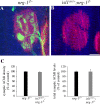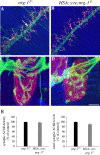Neuromuscular synapse formation in mice lacking motor neuron- and skeletal muscle-derived Neuregulin-1
- PMID: 16407563
- PMCID: PMC6674415
- DOI: 10.1523/JNEUROSCI.4506-05.2006
Neuromuscular synapse formation in mice lacking motor neuron- and skeletal muscle-derived Neuregulin-1
Abstract
The localization of acetylcholine receptors (AChRs) to the vertebrate neuromuscular junction is mediated, in part, through selective transcription of AChR subunit genes in myofiber subsynaptic nuclei. Agrin and the muscle-specific receptor tyrosine kinase, MuSK, have critical roles in synapse-specific transcription, because AChR genes are expressed uniformly in mice lacking either agrin or MuSK. Several lines of evidence suggest that agrin and MuSK stimulate synapse-specific transcription indirectly by regulating the distribution of other cell surface ligands, which stimulate a pathway for synapse-specific gene expression. This putative secondary signal for directing AChR gene expression to synapses is not known, but Neuregulin-1 (Nrg-1), primarily based on its presence at synapses and its ability to induce AChR gene expression in vitro, has been considered a good candidate. To study the role of Nrg-1 at neuromuscular synapses, we inactivated nrg-1 in motor neurons, skeletal muscle, or both cell types, using mice that express Cre recombinase selectively in developing motor neurons or in developing skeletal myofibers. We find that AChRs are clustered at synapses and that synapse-specific transcription is normal in mice lacking Nrg-1 in motor neurons, myofibers, or both cell types. These data indicate that Nrg-1 is dispensable for clustering AChRs and activating AChR genes in subsynaptic nuclei during development and suggest that these aspects of postsynaptic differentiation are dependent on Agrin/MuSK signaling without a requirement for a secondary signal.
Figures






Similar articles
-
Induction of multiple signaling loops by MuSK during neuromuscular synapse formation.Proc Natl Acad Sci U S A. 2001 Dec 4;98(25):14655-60. doi: 10.1073/pnas.251291598. Epub 2001 Nov 20. Proc Natl Acad Sci U S A. 2001. PMID: 11717400 Free PMC article.
-
A novel pathway for MuSK to induce key genes in neuromuscular synapse formation.J Cell Biol. 2003 May 26;161(4):727-36. doi: 10.1083/jcb.200210156. Epub 2003 May 19. J Cell Biol. 2003. PMID: 12756238 Free PMC article.
-
Distinct roles of nerve and muscle in postsynaptic differentiation of the neuromuscular synapse.Nature. 2001 Apr 26;410(6832):1057-64. doi: 10.1038/35074025. Nature. 2001. PMID: 11323662
-
Development of the neuromuscular junction.Cell Tissue Res. 2006 Nov;326(2):263-71. doi: 10.1007/s00441-006-0237-x. Epub 2006 Jul 4. Cell Tissue Res. 2006. PMID: 16819627 Review.
-
Neural agrin: a synaptic stabiliser.Int J Biochem Cell Biol. 2007;39(5):863-7. doi: 10.1016/j.biocel.2006.10.012. Epub 2006 Oct 25. Int J Biochem Cell Biol. 2007. PMID: 17126587 Review.
Cited by
-
Neuregulin-ERBB signaling in the nervous system and neuropsychiatric diseases.Neuron. 2014 Jul 2;83(1):27-49. doi: 10.1016/j.neuron.2014.06.007. Neuron. 2014. PMID: 24991953 Free PMC article. Review.
-
Reinnervation of the tibialis anterior following sciatic nerve crush injury: a confocal microscopic study in transgenic mice.Exp Neurol. 2007 Sep;207(1):64-74. doi: 10.1016/j.expneurol.2007.05.028. Epub 2007 Jun 14. Exp Neurol. 2007. PMID: 17628540 Free PMC article.
-
Uncovering molecular biomarkers that correlate cognitive decline with the changes of hippocampus' gene expression profiles in Alzheimer's disease.PLoS One. 2010 Apr 13;5(4):e10153. doi: 10.1371/journal.pone.0010153. PLoS One. 2010. PMID: 20405009 Free PMC article.
-
Identification of Erbin interlinking MuSK and ErbB2 and its impact on acetylcholine receptor aggregation at the neuromuscular junction.J Neurosci. 2010 May 12;30(19):6620-34. doi: 10.1523/JNEUROSCI.5778-09.2010. J Neurosci. 2010. PMID: 20463225 Free PMC article.
-
Molecular control of neuromuscular junction development.J Cachexia Sarcopenia Muscle. 2012 Mar;3(1):13-23. doi: 10.1007/s13539-011-0041-7. Epub 2011 Oct 14. J Cachexia Sarcopenia Muscle. 2012. PMID: 22450265 Free PMC article.
References
-
- Buonanno A, Fischbach GD (2001) Neuregulin and ErbB receptor signaling pathways in the nervous system. Curr Opin Neurobiol 11: 287-296. - PubMed
-
- Burden SJ (2002) Building the vertebrate neuromuscular synapse. J Neurobiol 53: 501-511. - PubMed
-
- Chu GC, Moscoso LM, Sliwkowski MX, Merlie JP (1995) Regulation of the acetylcholine receptor epsilon subunit gene by recombinant ARIA: an in vitro model for transynaptic gene regulation. Neuron 14: 329-339. - PubMed
-
- Cohen I, Rimer M, Lomo T, McMahan UJ (1997) Agrin-induced postsynaptic-like apparatus in skeletal muscle fibers in vivo. Mol Cell Neurosci 9: 237-253. - PubMed
-
- Corfas G, Rosen KM, Aratake H, Krauss R, Fischbach GD (1995) Differential expression of ARIA isoforms in the rat brain. Neuron 14: 103-115. - PubMed
Publication types
MeSH terms
Substances
Grants and funding
LinkOut - more resources
Full Text Sources
Other Literature Sources
Molecular Biology Databases
